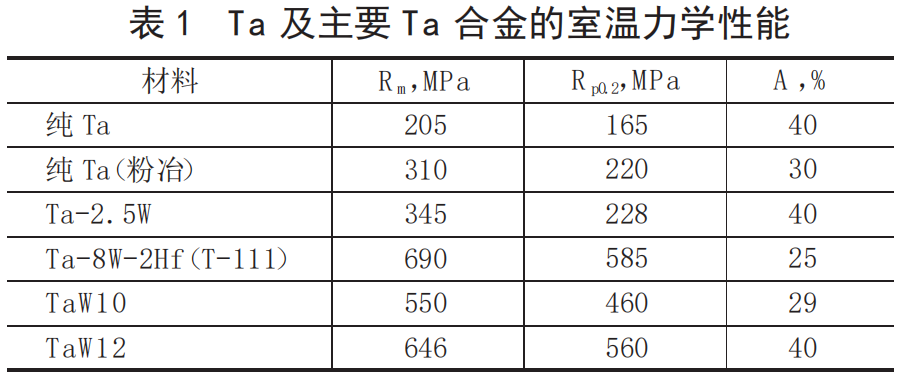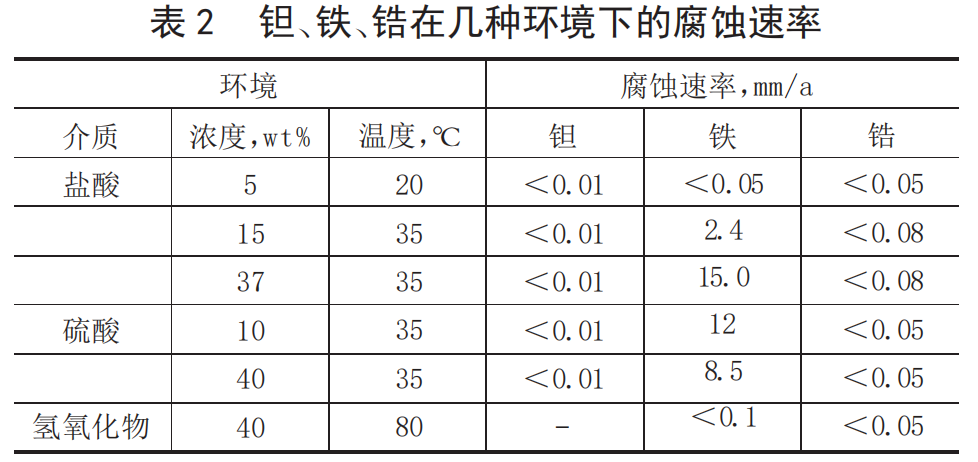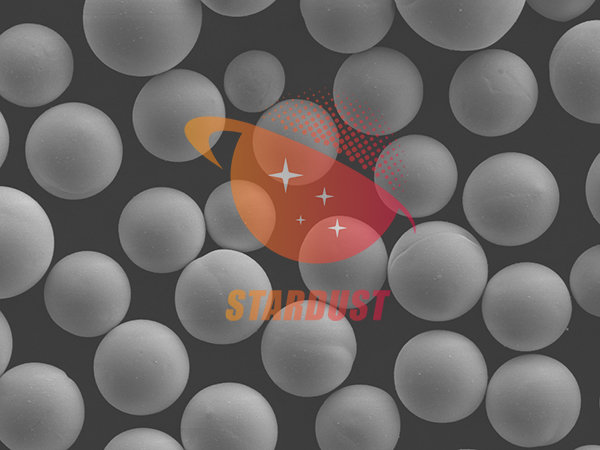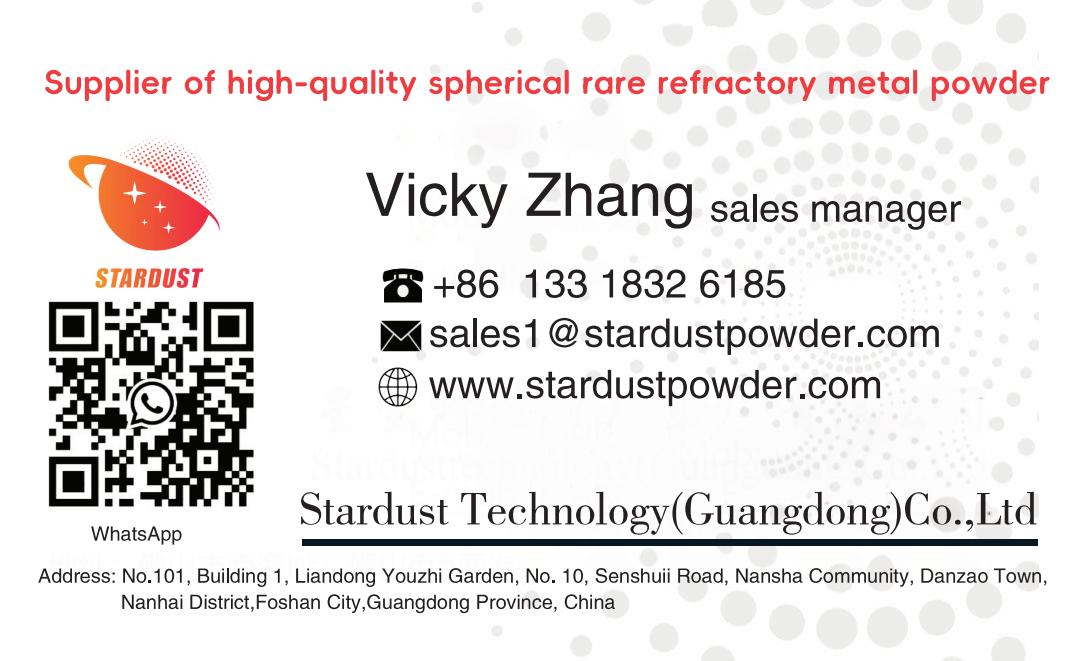
Tantalum and tantalum alloys have the characteristics of high density, high melting point, corrosion resistance, excellent high temperature strength, good processability, etc., and are widely used in electronics, chemical industry, aerospace, weapons and equipment and other fields.
Tantalum is a refractory metal with an average content of about 1.6×10-6% in the earth's crust. Metallic tantalum was discovered by Swedish chemist A.G.Ekeberg in 1802 and industrialized in 1922 by the American Fan Steel Company. The world's tantalum resources are mainly distributed in Australia, Brazil, Canada and other countries. Tantalum and tantalum alloys have the advantages of high density, high melting point, corrosion resistance, excellent high temperature strength, good processability, weldability and low plastic/brittle transition temperature. They are widely used in electronics, chemical industry, aerospace, weapons and equipment and other fields due to their excellent dynamic mechanical properties and the formation of a dense, stable, high dielectric constant amorphous oxide film on the surface after oxidation treatment.
1 Performance of Tantalum and Tantalum Alloys
High-purity tantalum materials have excellent plasticity, and their mechanical properties are very sensitive to temperature and strain rate. At room temperature, the work hardening degree of tantalum is very low, and deep cold working can be performed, and the cold rolling deformation can exceed 97%. In an inert atmosphere, tantalum and its alloys have good high-temperature mechanical properties. Adding 2.5% to 10% tungsten to tantalum can improve the strength of the material. The alloying of tungsten to tantalum forms a substitutional continuous solid solution that still maintains the body-centered cubic crystal structure of tantalum, while also maintaining the easy processing properties of tantalum. Currently, the tantalum alloys widely used in industry are mainly Ta-2.5W, Ta-8W-2Hf, TaW10, TaW12 and Ta-Ta2C composite materials. Table 1 gives the general properties of tantalum and tantalum alloys.

2 Main applications of tantalum and its alloys
2. 1 Tantalum for chemical equipment
Tantalum is different from other refractory metals with body-centered cubic crystals, such as tungsten and molybdenum. Tantalum has a very high affinity with interstitial atoms (N, C, H), and the compounds formed with them are very stable even at high temperatures. There is a TaO passivation layer on the surface of metallic tantalum that can adsorb O. This dense oxide layer makes tantalum have excellent corrosion resistance to water-soluble substances and most liquid metals. Only HF, fuming sulfuric acid and caustic alkali can corrode it. Generally speaking, the corrosion rate of most metals and their alloys in chemical environments is 0.13 mm/a ~ 0.51 mm/a, while that of tantalum is 0 mm/a ~ 0.05 mm/a. When tantalum is immersed in sulfuric acid at 200 ℃ for one year, the surface is only damaged by 0.006 mm. Among more than 2,000 chemical reagents, tantalum is corroded by only 40 reagents. Table 2 gives the corrosion rates of tantalum, iron and zirconium in several environments.

Tantalum is used in various parts of chemical equipment, such as heat exchangers, shell and tube heaters, bayonet heaters, evaporators, condensers, thermowells, (explosion) safety plates, container linings and glass container repair parts. Usually, larger parts are coated with a thin layer of tantalum on the metal surface (such as steel, stainless steel and copper), which can be physically bonded or explosively bonded. The cost of graphite shell and tube heat exchangers is only 20% of that of tantalum heat exchangers, and the life of graphite heat exchangers is 3 to 5 years, but tantalum heat exchangers are at least 20 years. Tantalum is the material of choice for manufacturing equipment for handling hot concentrated sulfuric acid. Because tantalum is of considerable importance to the sulfuric acid industry, the corrosion rate of tantalum in sulfuric acid with a concentration of 96% and a temperature of 210°C is 0.05 ram/a; in terms of acceptable corrosion rate, the passivation performance of tantalum is still good under the condition of reaching 230°C. The sulfuric acid evaporator mainly uses Ta2.5W alloy. The tantalum evaporator of the device is an insert heat exchanger. The insert tube is a stainless steel tube. The medium in the tube is 10 MPa ~ 12 MPa water vapor. The casing is a Ta2.5W alloy tube. The outside of the tantalum tube is waste sulfuric acid and a small amount of nitric acid. Dale Lathrop Company in Ohio, USA, has successfully developed a highly corrosion-resistant chemical tantalum alloy "Ultra 76", which has both excellent hydrogen embrittlement resistance and high general corrosion resistance. The hydrogen embrittlement resistance and corrosion resistance of the "Ultra 76" alloy in the corrosive HC1 environment are 1 to 2 orders of magnitude higher than those of traditional tantalum alloys, and 5 to 10 times higher than those of ordinary tantalum alloys in corrosive sulfuric acid solutions. The mechanical properties of the new alloy are equivalent to those of traditional tantalum alloys and can be processed and manufactured using the same processing methods. It is reported that the corrosion rate of this alloy in high-temperature hydrochloric acid is 1/4 of Ta-2.5W, and the corrosion rate in high-temperature sulfuric acid is 1/2 of Ta-2.5W.
2. 2 Tantalum for the electronics industry
The electronics industry is the largest user of tantalum materials, and capacitors made of tantalum have high reliability and compactness. Tantalum capacitors do not need to be fired with aluminum-coated capacitor paper like ordinary electrolytic capacitors, and they have almost no inductance. In addition, since there is no electrolyte inside the tantalum capacitor, it is very suitable for working at high temperatures. Tantalum capacitors are characterized by long life, high temperature resistance, high accuracy, and excellent high-frequency harmonic filtering performance. Tantalum capacitors can work normally in harsh environments with drastic temperature changes, and they are small in size and large in capacity (the capacitance is 5 to 6 times that of other capacitors of the same volume). They are widely used in electronic circuits such as electronic computers, radars, missiles, supersonic aircraft, and automatic control devices. Even in new integrated circuits, tantalum is an indispensable and important material. The sealed shell of tantalum capacitors can be made by the reverse extrusion process of tantalum rods, or by tantalum sheets or tantalum tubes. When making tantalum tubes, the tubes are first cut and then welded to seal the bottom. To produce products with consistent performance, controlling the performance of tantalum materials is a key factor. It is necessary to meet processing requirements and ensure product quality. Therefore, when making tantalum materials for capacitor sealed shells, both plasticity and strength requirements are required. The typical properties of tantalum sheets required in actual production include: tensile strength of 310 MPa ~ 380 MPa, yield strength of about 276 MPa, and elongation of 35 ~ 45.
2. 3 Tantalum for weapons and equipment
In the 1980s, a new type of warhead for weapon and equipment systems, the explosively formed armor-piercing projectile (EFP), came into being. EFP is a disc-shaped gasket filled with powerful explosives. When the explosive explodes, the disc-shaped gasket is deformed into an aerodynamic long rod-shaped armor-piercing projectile and accelerates towards the target. EFP has stronger penetration ability than traditional kinetic armor-piercing warheads. The traditional charge liner material uses red copper, which has made great contributions to the application of armor-piercing weapons in the decades of use. At present, copper as the traditional EFP warhead liner material can no longer adapt to the rapid development of protective armor technology, which forces warhead research to seek new liner materials. The density of tantalum is 16.6 g/cm-3, which is 1.86 times that of copper. The use of high-density materials to make liner can greatly improve the penetration power of EFP. Ballistic tests show that the penetration performance of tantalum is 30%~35% higher than that of copper. From the perspective of improving the armor-piercing power of armor-piercing projectiles, tantalum and tantalum alloys can be used as ideal substitutes for copper liner. As early as the late 1980s, the United States and other Western countries began to study the possibility of tantalum as a warhead liner material, and have achieved great results. Pure tantalum materials or tantalum alloys have been used in EFP warhead liner. The processing methods of tantalum and tantalum alloy liner (spherical liner) are mainly mechanical processing, sheet stamping and swing rolling. At present, the research on tantalum and tantalum alloy liner materials is mainly focused on improving processing technology to improve the organization of liner materials and reduce production costs. Tantalum and tantalum alloy liner materials are being used on a large scale.
2.4 High temperature application
The melting point of pure tantalum can reach 2996℃. Tantalum alloy is a good material for high temperature furnace components, such as trays, heating elements and heat shields. Tantalum and niobium are excellent additives for super heat-resistant alloys. This alloy is mainly used to manufacture turbine components and jet engine parts, and about 90% of its demand is for space navigation and aviation industries. Adding a small amount of yttrium as a grain stabilizer for tantalum and adding an appropriate amount of tungsten can improve the high temperature strength of tantalum. In order to improve the creep resistance of tantalum, 2.5% hafnium can be added to tantalum-tungsten alloy. Hafnium is enriched on the grain boundaries and can prevent grain boundary sliding, such as T-1ll alloy. T-1ll alloy is now used as a reinforced structural material for wrapping the heat source of cosmic thermoelectric generators. TaW10 alloy is an important rocket nozzle material and occupies an extremely important position in aerospace and missile technology.
With the rapid growth of the global economy, the electronics, military, chemical and other industries are about to enter a new round of growth cycle. The development trend of the Internet of Things, mobile Internet and China's mechanization, automation and intelligentization has also been determined. These will promote the demand for tantalum and tantalum alloys, and usher in a period of rapid development for the tantalum industry.
About Stardust Technology
Stardust Technology (Guangdong) Co., Ltd. is a national high-tech enterprise specializing in the research, development, production and sales of high-end spherical powder materials for 3D printing, powder metallurgy, surface engineering and other fields. The company insists on taking radio frequency plasma spheroidization powder making technology as the core and providing internationally advanced powder products and application solutions.
The company's main products include high-end rare refractory metals such as tungsten, molybdenum, tantalum, niobium, vanadium, rhenium, chromium and their alloys, compound spherical powders, and also provides technical services such as radio frequency plasma spheroidization, plasma rotating electrode atomization, 3D printing, hot isostatic pressing, injection molding, powder metallurgy, etc.
The spherical Ta-W refractory alloy powder produced by Stardust Technology is made by radio frequency plasma spheroidization atomization method. It has the characteristics of high purity oxygen deficiency, high sphericity, smooth surface, no satellite, uniform particle size distribution, excellent flowability, high loose density and vibration density. Tantalum tungsten alloy is a high-density material with high melting point, high tensile strength, good dynamic ductility and corrosion resistance. It is used in chemical corrosion protection, machinery, aerospace and military fields.
https://www.stardustpowder.com/tantalum-10-tungsten-powder15-53mm

For more details, please contact us

Article source: "Equipment Manufacturing Technology" 2013 Issue 8 China Library
Classification Number: TG146.416 Document Identification Code: B Article Number: 1672-545X (2013) 08-0115-03